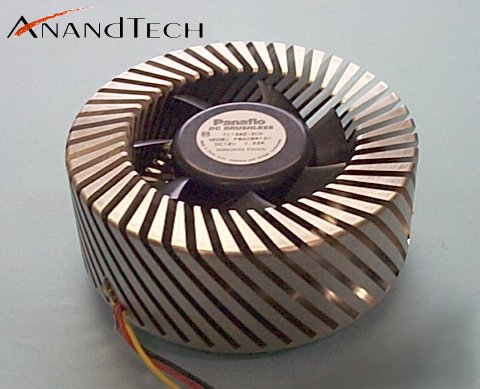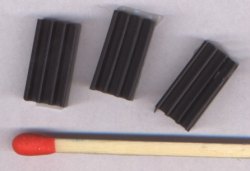Athlon Heatsink Roundup (February 2000)
by Tillmann Steinbrecher on February 21, 2000 12:00 PM EST- Posted in
- Cases/Cooling/PSUs

As you can see, this unit looks a lot different from other heatsinks. The cooler is produced using CNC milling, which is a very expensive production method - but since these heatsinks are surplus, they're available at affordable prices, and even the ArcticCircle with Athlon clips is not extremely expensive.
HP's innovative heatsink design is certainly good.- Considering the compactness and the fact that it is only equipped with one fan, the performance is remarkable. Even though it does not cool as well as the Global WIN VOS32 and the Alpha P7125, it is still suitable for overclocking. One thing that helps the ArcticCircle to perform well is the fact that it is mounted directly on the Athlon CPU core, without the Athlon's thermal transfer plate. This is both an advantage and a disadvantage - the advantage is that there is less thermal resistance between CPU and heatsink; the disadvantage is that you'll have to open your Athlon (thus voiding its warranty) and remove the thermal plate. But since overclockers will have to open their Athlon anyway in order to install the "gold finger overclocking device", this disadvantage shouldn't really matter. Unfortunately, the ArcticCircle is not compatible with all Athlon overclocking devices - it won't work with the Outer Loop Afterburner card because of a mechanical problem. However, other overclocking devices will work.
 If
the Athlon thermal transfer plate is removed, the Athlon's cache chips
aren't cooled anymore. To solve this problem, Montac includes tiny heatsinks
for the cache chips with the ArcticCircle. Three of these mini-heatsinks
(see picture) should be installed on each cache chip. Despite their small
size, they definitely provide sufficient cooling for the cache chips -
compared to the CPU, the cache does not emit much heat, and the ArcticCircle
blows quite a lot of air towards the cache, so with the small heatsinks,
the cache chips stay comfortably cool.
If
the Athlon thermal transfer plate is removed, the Athlon's cache chips
aren't cooled anymore. To solve this problem, Montac includes tiny heatsinks
for the cache chips with the ArcticCircle. Three of these mini-heatsinks
(see picture) should be installed on each cache chip. Despite their small
size, they definitely provide sufficient cooling for the cache chips -
compared to the CPU, the cache does not emit much heat, and the ArcticCircle
blows quite a lot of air towards the cache, so with the small heatsinks,
the cache chips stay comfortably cool.
As interface material for the "main" heatsink, Montac includes a tiny ziplock bag with a drop of thermal compound.
The fan
Installation
The heatsink is attached to the CPU using four screws. The plastic case of the Athlon can be either left on or removed. If it is left on, you will have to cut out a part of it, and drill four holes into the case. Montac includes everything you'll need for installation: A printed manual with pictures, all screws, plastic spacers, and even alcohol swabs to clean the CPU core and the cache chips before installing the heatsinks. Installation is a bit time-consuming, but with some patience, the ArcticCircle can be installed easily, thanks to the installation manual. The weak point is the cache heatsink installation: They are fixed using thermoconductive tape, and it's quite difficult to get the protection film off the tape. Also, it remains to be seen whether the tape will hold the small heatsinks reliably over the years. The cache heatsinks could be removed very easily after the test. The mounting mechanism for the actual "CPU heatsink" is very good, it allows compressive mounting, which is good for thermal transfer between CPU and heatsink.
Conclusion
While not the top performer in this comparison, this heatsink was nevertheless very convincing: "Smart" design that combines compactness and efficiency, good mounting mechanism, and it can be mounted directly on the CPU core. However, the HP heatsinks on which the ArcticCircle is based are no longer in production, so it looks like this cooler will only be available for a limited time.
| Montac ArcticCircle at a glance |
|
Fan:
One 60mm Panaflo
Fan
rpm (measured): unknown
|
| Advantages |
|
| Disadvantages |
|










0 Comments
View All Comments